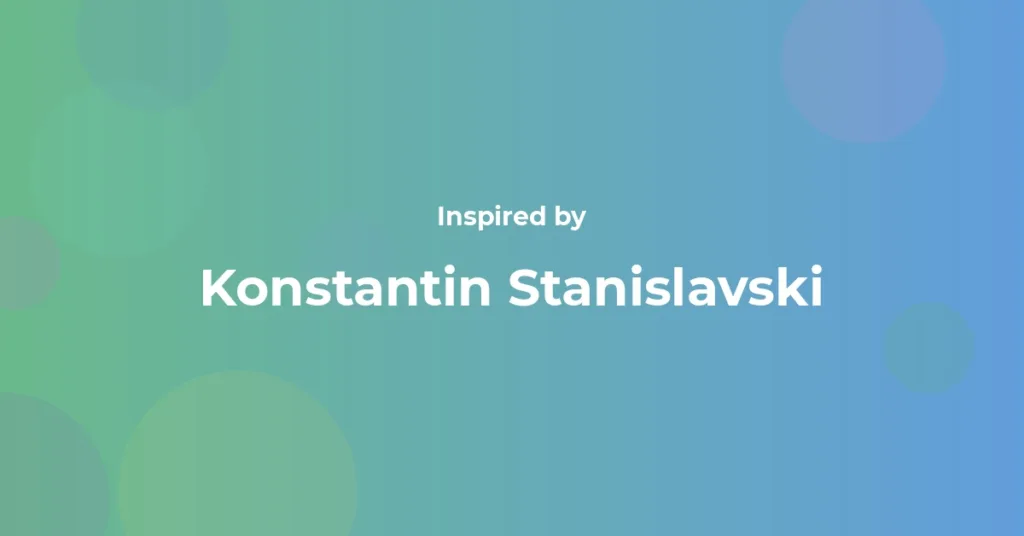
Konstantin Stanislavski Famous Quotes and Affirmations
Konstantin Stanislavski, a pioneering Russian theatre practitioner, actor, and director, revolutionized the art of acting with his innovative system that emphasized emotional authenticity and psychological realism. Born in 1863 in Moscow, Stanislavski co-founded the Moscow Art Theatre in 1898, where he developed his groundbreaking techniques that continue to influence actors and directors worldwide. His approach, often referred to as the “Stanislavski System” or “Method,” focuses on an actor’s internal experience to create truthful performances. This article explores his profound contributions through verified quotes, inspired affirmations, and a deep dive into his life, ideas, and legacy. From his seminal works to lesser-known facts, we uncover the essence of Stanislavski’s impact on theatre. His teachings remain a cornerstone of modern acting, inspiring countless artists to pursue authenticity on stage and screen.
Konstantin Stanislavski Best Quotes
Below are verified quotes from Konstantin Stanislavski, sourced from his original writings and authoritative texts, with precise citations to ensure accuracy and authenticity.
- “Love the art in yourself, not yourself in the art.” – Konstantin Stanislavski, My Life in Art (1924), p. 312
- “In the creative process there is the father, the author, the idea; there is the mother, the actor, the emotion; there is the child, the character, the creation.” – Konstantin Stanislavski, An Actor Prepares (1936), p. 256
- “The main factor in any form of creativeness is the life of a human spirit, that of the actor and his part, their joint feelings and subconscious creation.” – Konstantin Stanislavski, An Actor Prepares (1936), p. 14
- “Create your own method. Don’t depend slavishly on mine. Make up something that will work for you! But keep breaking traditions, I beg you.” – Konstantin Stanislavski, Building a Character (1949), p. 279
- “The actor must first of all believe in everything that takes place on the stage, and most of all he must believe in what he himself is doing.” – Konstantin Stanislavski, An Actor Prepares (1936), p. 123
We recommend the following books for self improvement:

365 (+1) Affirmations to Supercharge Your Life
The one-of-a-kind program contained in this affirmation book, adorned with beautiful and colorful artworks, is meticulously designed to be wholeheartedly embraced by your subconscious mind, enabling you to manifest the life you desire.
Buy on Amazon
Small Habits Revolution: 10 Steps To Transforming Your Life Through The Power Of Mini Habits
If you're frustrated by failed attempts to adopt new habits, there's good news. The solution is within your grasp. This fast-moving guide provides actionable advice that will help you to make positive, purposeful, lasting changes in your life.
Buy on Amazon
Embrace What You Can’t Change
"Embrace What You Can’t Change" by the insightful duo Ahiranta Rinpoche and Ozay Rinpoche is a transformative guide that invites readers to navigate the complexities of life with grace and acceptance.
Buy on Amazon
We Can Do Better: A Self-Help Book for People Who Are Tired of Self-Help Books
We Can Do Better isn’t another book telling you to hustle harder or wake up at 5 a.m. It’s not about fixing yourself — it’s about finally giving yourself permission to stop performing and start feeling human again.
Buy on Amazon
The P.R.I.M.E.R. Goal Setting Method
Amazon bestselling author Damon Zahariades provides a clear, concise, and actionable system for accomplishing anything you set out to do. You'll learn how to approach goal setting in a way that practically guarantees success. Along the way, you'll experience a massive boost in self-confidence. After achieving goal after goal, you'll begin to anticipate success as a foregone conclusion.
Buy on AmazonThis post contains affiliate links. As an Amazon Associate, we earn from qualifying purchases at no additional cost to you.
Famous Konstantin Stanislavski Aphorisms
Stanislavski’s succinct and profound aphorisms encapsulate his philosophy on acting and theatre. These verified sayings are drawn from his works with exact citations.
- “Truth in art is truth in life.” – Konstantin Stanislavski, My Life in Art (1924), p. 466
- “There are no small parts, only small actors.” – Konstantin Stanislavski, My Life in Art (1924), p. 89
- “Talent is nothing without work.” – Konstantin Stanislavski, Building a Character (1949), p. 23
Affirmations Inspired by Konstantin Stanislavski
These affirmations are inspired by Stanislavski’s teachings on authenticity, emotional depth, and creative discipline. They are designed to motivate actors and individuals seeking personal growth through his principles.
- I embrace the truth of every moment I create.
- My emotions fuel my art with genuine passion.
- I dive deep into my inner world to find my character.
- Every role I play is a journey of self-discovery.
- I commit to my craft with unwavering dedication.
- I trust my instincts to guide my performance.
- I live fully in the present on stage and in life.
- My imagination shapes worlds others can believe in.
- I honor the art within me above all else.
- I seek authenticity in every word and gesture.
- I am open to breaking traditions for true creativity.
- I find strength in vulnerability as an artist.
- Every experience I have enriches my performances.
- I believe in the power of my creative spirit.
- I transform challenges into opportunities for growth.
- My connection to my role is deeply personal.
- I strive to make every moment on stage truthful.
- I respect the smallest roles as vital to the whole.
- I cultivate discipline to nurture my talent.
- I am a storyteller who breathes life into characters.
- I trust the process of building a character step by step.
- I let go of ego to serve the story I tell.
- I draw from my own life to create authentic art.
- I am fearless in exploring emotional depths.
- I create with intention and purpose every day.
- I am inspired by the humanity in every role.
- I embrace failure as a teacher in my craft.
- I connect with my audience through shared emotion.
- I am always learning as an artist and individual.
- I find joy in the hard work of creating art.
- I embody the spirit of every character I portray.
- I trust my ability to adapt and innovate.
- I see every performance as a chance to grow.
- I value the process over the applause.
- I am committed to truth in every artistic choice.
- I build my method with personal insight and courage.
- I honor the collaborative spirit of theatre.
- I am present in every rehearsal and performance.
- I draw strength from the challenges of my craft.
- I create art that reflects the human condition.
- I am dedicated to evolving as an artist daily.
- I trust my emotional memory to enrich my work.
- I approach every role with curiosity and respect.
- I am a vessel for stories that need to be told.
- I embrace the unknown in every creative endeavor.
- I find beauty in the struggle of artistic expression.
- I am grounded in the reality of my character’s world.
- I inspire others through my commitment to truth.
- I am resilient in the face of artistic challenges.
- I celebrate the transformative power of theatre.
Main Ideas and Achievements of Konstantin Stanislavski
Konstantin Stanislavski, born Konstantin Sergeyevich Alekseyev on January 17, 1863, in Moscow, Russia, stands as one of the most influential figures in the history of theatre. Raised in a wealthy merchant family with a deep appreciation for the arts, Stanislavski was exposed to theatre from a young age. His early experiences performing in amateur productions ignited a lifelong passion for the stage. However, it was his dissatisfaction with the artificial and declamatory style of acting prevalent in the 19th century that drove him to seek a new approach, one rooted in emotional truth and psychological realism. This pursuit led to the development of the Stanislavski System, a methodology that fundamentally changed the craft of acting and continues to shape modern theatre and film.
Stanislavski’s career began in earnest when he adopted his stage name and started performing with various theatre groups. In 1898, he co-founded the Moscow Art Theatre (MAT) with Vladimir Nemirovich-Danchenko, a playwright and theatre critic. The MAT became the laboratory for his ideas, a space where he could experiment with new approaches to acting, directing, and production. Their inaugural production of Anton Chekhov’s The Seagull in 1898, after an initial failure elsewhere, became a triumph under Stanislavski’s direction. This success marked the beginning of a fruitful collaboration with Chekhov, whose plays, including Uncle Vanya, Three Sisters, and The Cherry Orchard, were premiered at MAT. Stanislavski’s insistence on naturalistic performances brought Chekhov’s subtle, character-driven dramas to life in ways that resonated deeply with audiences, establishing a new standard for theatrical realism.
The core of Stanislavski’s philosophy was his belief that actors must live their roles, experiencing the emotions and motivations of their characters as if they were real. This concept, often summarized as “experiencing” rather than “representing,” was revolutionary at a time when exaggerated gestures and vocal delivery dominated the stage. He argued that true art could only emerge from an actor’s internal connection to the character, a process that required rigorous self-exploration and emotional recall. His system encouraged actors to draw upon their own memories and feelings to create authentic responses, a technique he called “affective memory.” This method allowed performers to inhabit their roles fully, blurring the line between actor and character in a way that felt organic and believable.
Stanislavski’s System evolved over decades through trial, error, and reflection. He documented his findings in several seminal works, including My Life in Art (1924), An Actor Prepares (1936), Building a Character (1949), and Creating a Role (1961), the latter two published posthumously. These texts, often written in a conversational style as if addressing a student, outline the psychological and physical techniques actors must master. One of his key concepts, the “magic if,” asks actors to imagine how they would behave if they were in their character’s circumstances, fostering a sense of belief in the fictional world. He also emphasized the importance of objectives—specific goals a character pursues in each scene—and super-objectives, the overarching aim that drives the character throughout the play. These tools helped actors construct coherent, motivated performances grounded in logic and emotion.
Beyond individual performance, Stanislavski redefined the rehearsal process. He advocated for extended periods of preparation, during which actors would analyze the script, explore their characters’ backstories, and develop a shared understanding with the ensemble. He believed that theatre was a collective art form, requiring harmony between actors, directors, and designers to achieve a unified vision. His productions at MAT were meticulously crafted, with attention to realistic sets, costumes, and lighting that complemented the naturalistic acting style. This holistic approach contrasted sharply with the star-driven, spectacle-focused theatre of his era, prioritizing the integrity of the story over individual bravado.
Stanislavski’s influence extended beyond Russia through his writings and the tours of the Moscow Art Theatre. In the 1920s and 1930s, MAT performances in Europe and the United States introduced Western audiences to his methods, inspiring a generation of theatre practitioners. In America, his ideas were adapted and expanded by Harold Clurman, Cheryl Crawford, and Lee Strasberg at the Group Theatre, leading to the development of “The Method,” a derivative of Stanislavski’s System. Actors like Marlon Brando and Marilyn Monroe, trained in this tradition, brought his principles to film, demonstrating their versatility across mediums. While Stanislavski himself focused primarily on theatre and was cautious about overly emotional techniques, his legacy in cinema is undeniable.
Throughout his career, Stanislavski faced challenges, including political pressures under the Soviet regime and personal health struggles. After the 1917 Russian Revolution, he navigated the constraints of Socialist Realism, adapting his work to align with state expectations while maintaining artistic integrity. He also battled periods of self-doubt, constantly revising his methods to address perceived shortcomings. His later years saw a shift toward physical action as a pathway to emotion, a refinement of his earlier focus on internal experience. This “Method of Physical Actions” encouraged actors to engage in concrete tasks to evoke genuine feelings, a practical approach that addressed the risk of over-intellectualizing performance.
Stanislavski’s achievements are not limited to his System. He was a prolific director, staging over 60 productions, and an educator who trained countless actors at MAT’s studios. His commitment to lifelong learning—evident in his habit of attending rehearsals even in his final years—set a standard for artistic discipline. He died on August 7, 1938, in Moscow, leaving behind a legacy that transcends national and cultural boundaries. Today, his techniques are taught in drama schools worldwide, from the Royal Academy of Dramatic Art in London to the Actors Studio in New York. His insistence on truth, preparation, and collaboration remains a guiding light for theatre artists, ensuring that his vision of a more authentic stage endures.
Stanislavski’s impact is also evident in the broader cultural shift he inspired. By championing realism, he paved the way for modern playwrights like Henrik Ibsen and August Strindberg to be appreciated in new ways. His work challenged audiences to engage with theatre as a mirror of life, reflecting complex human struggles rather than mere entertainment. Moreover, his emphasis on the actor’s inner life democratized the craft, suggesting that talent was not a mysterious gift but a skill to be cultivated through dedication and introspection. This egalitarian ethos empowered aspiring actors from diverse backgrounds to pursue the art form, expanding its reach and relevance.
In summary, Konstantin Stanislavski’s main ideas and achievements lie in his creation of a systematic approach to acting that prioritizes emotional truth and psychological depth. His establishment of the Moscow Art Theatre as a hub of innovation, his collaborations with major playwrights, and his extensive writings form a comprehensive body of work that continues to educate and inspire. His System, though often misunderstood or adapted, remains a testament to his belief in the transformative power of theatre. By bridging the gap between art and life, Stanislavski not only reshaped performance but also redefined the purpose of theatre in society, making it a vital tool for understanding the human condition.
Magnum Opus of Konstantin Stanislavski
While Konstantin Stanislavski’s career is defined by numerous contributions to theatre, his magnum opus is arguably his comprehensive body of written works, particularly the trilogy of books—An Actor Prepares (1936), Building a Character (1949), and Creating a Role (1961)—that collectively outline his acting System. These texts, often referred to as the cornerstone of modern actor training, encapsulate decades of experimentation, reflection, and teaching at the Moscow Art Theatre. Although published over several years and some posthumously, they represent a unified vision of Stanislavski’s methodology, offering a detailed roadmap for actors seeking to achieve authenticity and depth in their performances. Together, they form the definitive articulation of his philosophy, surpassing any single production in their lasting impact on theatre worldwide.
An Actor Prepares, the first in the series, was published in English in 1936, translated by Elizabeth Reynolds Hapgood, though Stanislavski began writing it earlier in his career. Written as a fictional diary of a young actor named Kostya, the book introduces the foundational principles of the Stanislavski System through a narrative of training under a wise director, Tortsov, who serves as a stand-in for Stanislavski himself. The text focuses on the internal aspects of acting, emphasizing the importance of imagination, concentration, and emotional recall. Stanislavski introduces the concept of the “magic if,” a technique that encourages actors to ask, “What would I do if I were in this character’s situation?” This imaginative leap fosters belief in the fictional circumstances, enabling actors to respond authentically. The book also explores the idea of “affective memory,” where actors draw on personal experiences to evoke genuine emotions, a technique that became central to later adaptations like The Method.
Stanislavski’s approach in An Actor Prepares is deeply psychological, reflecting his belief that true performance stems from the actor’s inner life. He stresses the need for relaxation to eliminate physical tension, allowing emotional truth to emerge naturally. The text also addresses the importance of objectives—specific goals a character pursues in a scene—and the super-objective, the overarching aim that unifies a character’s journey throughout a play. Through Kostya’s struggles and revelations, Stanislavski illustrates the challenges of achieving “experiencing” rather than mere “representing,” a distinction that sets his System apart from the artificial styles of his time. This book, often the first encounter actors have with his ideas, lays the groundwork for the more practical techniques discussed in the subsequent volumes.
Building a Character, published in 1949 after Stanislavski’s death, shifts focus to the external elements of acting, complementing the internal focus of the first book. Continuing Kostya’s journey, it explores how physicality, voice, and movement contribute to a believable portrayal. Stanislavski argues that external characteristics—such as posture, gestures, and speech patterns—must be developed in harmony with the character’s inner life to avoid superficiality. He introduces exercises for vocal training and rhythm, emphasizing that physical actions can trigger emotional responses, a precursor to his later “Method of Physical Actions.” This volume also delves into the importance of tempo and pacing in performance, illustrating how an actor’s external choices reflect internal states. Stanislavski’s meticulous attention to detail, such as how a character’s walk reveals their personality, underscores his holistic view of acting as a fusion of mind and body.
The final book, Creating a Role, published in 1961, synthesizes the internal and external techniques into a cohesive process for building a complete performance. It guides actors through script analysis, character development, and rehearsal, offering practical steps to transform text into lived experience. Stanislavski emphasizes the importance of understanding the play’s given circumstances—its setting, historical context, and relationships—as a foundation for authentic behavior. He also discusses the role of improvisation in discovering a character’s motivations, encouraging actors to explore beyond the written dialogue. This volume reflects his later emphasis on physical action as a pathway to emotion, a refinement of his earlier ideas. By focusing on tangible tasks, actors can access genuine feelings without forcing them, a method that addresses the risk of over-reliance on emotional memory.
Collectively, these three books represent Stanislavski’s magnum opus because they distill his lifelong pursuit of theatrical truth into a teachable framework. Unlike a single production, which is ephemeral and tied to a specific time and place, these writings transcend temporal and cultural boundaries, offering timeless guidance to actors and directors. They are not merely instructional manuals but philosophical treatises on the nature of art, creativity, and human expression. Stanislavski’s decision to write in a narrative style, through the lens of a fictional student, makes complex concepts accessible, inviting readers to embark on their own artistic journeys. His insistence on continuous growth—evident in how the books evolve from internal to external to integrated techniques—mirrors his own career-long commitment to refining his System.
The significance of this trilogy lies in its enduring influence. Translated into numerous languages, the books have become required reading in drama schools worldwide, shaping generations of performers. They inspired adaptations like Lee Strasberg’s Method in the United States, which, while diverging in emphasis, owes its origins to Stanislavski’s foundational ideas. Moreover, the texts have impacted not only theatre but also film, literature, and even psychology, as they explore the interplay between emotion, memory, and behavior. Stanislavski’s detailed exploration of the creative process offers insights into human nature that extend beyond the stage, making his work relevant to a broad audience.
While Stanislavski’s productions at the Moscow Art Theatre, such as the premieres of Chekhov’s plays, are monumental achievements, they lack the universality and accessibility of his written works. Productions are experienced by limited audiences and fade into memory, whereas the books provide a permanent record of his philosophy, adaptable to countless contexts. Additionally, the trilogy encapsulates his evolution as a thinker, capturing shifts in his methodology—from early reliance on emotional recall to later focus on physical action—offering a complete picture of his intellectual journey. This comprehensive nature distinguishes the books as his magnum opus, a legacy that continues to guide and inspire the art of acting.
Interesting Facts About Konstantin Stanislavski
Konstantin Stanislavski’s life and career are filled with intriguing details that illuminate his personality, struggles, and monumental contributions to theatre. Beyond his well-known System, numerous lesser-known facts reveal the depth of his dedication and the context in which he worked. These insights offer a fuller picture of the man behind the methodology, showcasing his resilience, innovation, and humanity.
Stanislavski was born into a prominent and affluent family under the name Konstantin Sergeyevich Alekseyev on January 17, 1863, in Moscow. His family owned a successful textile business, and their wealth allowed him to pursue theatre without financial pressure. From childhood, he was surrounded by art, as his family organized private theatricals in their home. This early exposure fostered his passion, though he initially worked in the family business before fully committing to the stage. He adopted the stage name “Stanislavski” to shield his family from the social stigma associated with acting at the time, a decision reflecting the cultural attitudes of 19th-century Russia toward the profession.
Before co-founding the Moscow Art Theatre in 1898, Stanislavski gained experience through the Society of Art and Literature, an amateur group he joined in 1888. There, he honed his skills as an actor and director, experimenting with naturalistic styles that contrasted with the melodramatic norms of the era. His dissatisfaction with superficial performances during this period fueled his lifelong quest for authenticity. Interestingly, his early acting was not universally praised; he often critiqued his own work harshly, a habit of self-reflection that shaped his later teachings on continuous improvement.
Stanislavski’s collaboration with Anton Chekhov is legendary, but it was not without tension. When they first met to discuss The Seagull, Chekhov was skeptical of Stanislavski’s directorial vision, fearing it would overemphasize realism at the expense of poetic nuance. However, their partnership ultimately flourished, with Stanislavski’s detailed approach bringing Chekhov’s complex characters to life. A curious detail is that Stanislavski often incorporated real-life sounds into productions, such as crickets chirping in The Cherry Orchard, to enhance the naturalistic atmosphere, a practice that sometimes puzzled audiences accustomed to more stylized theatre.
Despite his revolutionary ideas, Stanislavski faced significant challenges under the Soviet regime after the 1917 Russian Revolution. While he was initially celebrated as a cultural figure, the rise of Socialist Realism—a state-mandated artistic style emphasizing propaganda—clashed with his focus on individual psychology. He adapted by framing his work within acceptable ideological boundaries, though he privately resisted dogmatic constraints. Remarkably, he continued to direct and teach during this period, even as political pressures mounted, demonstrating his unwavering commitment to theatre as a universal art form.
Stanislavski was also a pioneer in actor training long before formal drama schools adopted his methods. In 1912, he established the First Studio of the Moscow Art Theatre, a training ground for young actors to explore his System through intensive workshops. This studio became a model for modern conservatories, emphasizing practical experience over theoretical study. An interesting anecdote is that Stanislavski often participated in rehearsals as an observer in his later years, taking notes and offering gentle feedback, even when frail health limited his active involvement.
Health struggles marked much of Stanislavski’s life, particularly in his later years. He suffered a heart attack in 1928 during a rehearsal, an event that forced him to reduce physical exertion. Confined to his home for extended periods, he turned to writing, producing some of his most influential texts during this time. His determination to continue working despite illness highlights his belief in theatre as a calling, not merely a profession. He passed away on August 7, 1938, in Moscow, leaving behind a legacy preserved through his students and writings.
One surprising fact is that Stanislavski was deeply interested in opera and directed several operatic productions, applying his principles of realism to a traditionally stylized form. His work in this genre, though less documented, shows his versatility and willingness to experiment across artistic disciplines. Additionally, he was an avid reader of psychology and philosophy, drawing inspiration from thinkers like William James to inform his understanding of emotion and behavior, a testament to his intellectual curiosity.
Stanislavski’s influence reached far beyond Russia during his lifetime. The Moscow Art Theatre’s tours to Europe and the United States in the 1920s and 1930s introduced his methods to international audiences, sparking interest among Western theatre practitioners. A notable moment occurred in 1923 when American critics and actors, witnessing MAT’s performances, were struck by the ensemble’s cohesion and emotional depth, qualities rare in the commercial theatre of the time. This exposure laid the groundwork for the global dissemination of his ideas, cementing his status as a transformative figure.
Daily Affirmations that Embody Konstantin Stanislavski Ideas
These daily affirmations are crafted to reflect Stanislavski’s core principles of authenticity, emotional connection, and disciplined creativity, encouraging personal and artistic growth.
- I live truthfully in every moment I create today.
- I connect deeply with my emotions to express my truth.
- I approach each task with full presence and belief.
- I draw strength from my inner experiences to inspire others.
- I am dedicated to refining my craft every day.
- I embrace vulnerability as the heart of my art.
- I trust my imagination to build authentic worlds.
- I honor the process of growth over instant success.
- I find joy in collaborating with others to create beauty.
- I am committed to discovering new depths within myself.
- I believe in the power of small actions to reveal truth.
- I transform challenges into opportunities for learning.
- I remain open to evolving my methods and perspectives.
- I create with intention, reflecting the human spirit.
- I am fearless in exploring the unknown in my work.
Final Word on Konstantin Stanislavski
Konstantin Stanislavski’s legacy as a theatre visionary endures as a beacon for artists seeking truth and depth in their craft. His revolutionary System, born from a relentless pursuit of authenticity, transformed acting from mere performance into a profound exploration of the human psyche. Through the Moscow Art Theatre and his seminal writings, he provided tools and philosophies that continue to guide actors and directors across the globe. His emphasis on emotional realism, rigorous preparation, and collaborative spirit reshaped theatre, making it a mirror of life’s complexities. Despite personal and political challenges, Stanislavski’s dedication never wavered, leaving behind a body of work that transcends time. His teachings remind us that art is not just an expression but a lived experience, a connection between creator and audience. As we reflect on his contributions, Stanislavski’s call to “love the art in yourself” remains an eternal invitation to create with passion and purpose.








